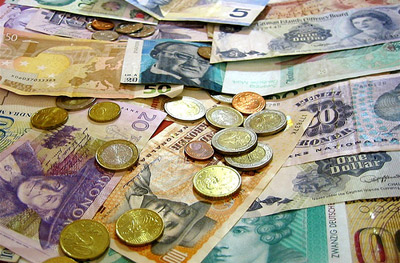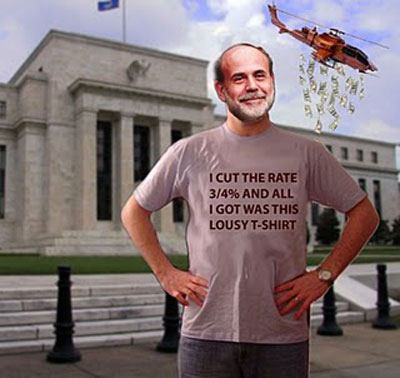The Economic Collapse
 Are you ready for a currency war? Well, buckle up, because things are about to get interesting. This week Japan fired what is perhaps the opening salvo in a new round of currency wars by publicly intervening in the foreign exchange market for the first time since 2004. Japan's bold 12 billion dollar move to push down the value of the yen made headlines all over the world. Japan's economy is highly dependent on exports and the Japanese government was becoming increasingly alarmed by the recent surge in the value of the yen. A stronger yen makes Japanese exports more expensive for other nations and thus would harm Japanese industry.
Are you ready for a currency war? Well, buckle up, because things are about to get interesting. This week Japan fired what is perhaps the opening salvo in a new round of currency wars by publicly intervening in the foreign exchange market for the first time since 2004. Japan's bold 12 billion dollar move to push down the value of the yen made headlines all over the world. Japan's economy is highly dependent on exports and the Japanese government was becoming increasingly alarmed by the recent surge in the value of the yen. A stronger yen makes Japanese exports more expensive for other nations and thus would harm Japanese industry.But Japan is not the only nation that is ready to go to battle over currency rates. The governments of the U.S. and China continue to exchange increasingly heated rhetoric regarding currency policy. In Europe, there is growing sentiment that the euro needs to be devalued in order to help European exports become more competitive. In addition, exporters all over the world are already loudly complaining about the possibility that the Federal Reserve is about to unleash another round of quantitative easing. Virtually all major exporting nations want the value of the U.S. dollar to remain high so that they can keep flooding us with lots of cheap goods. The sad reality is that our current system of globalized trade rewards exporting nations that have weak currencies, and many nations have now shown that they are willing to take the gloves off to make certain that their national currencies do not appreciate in value by too much.
Some nations have been involved in open currency manipulation for some time now. For example, Singapore is well known for intervening in the foreign exchange market in order to benefit exporters. Also, the Swiss National Bank experienced losses equivalent to about 15 billion dollars trying to stop the rapid rise of the Swiss franc earlier this year.
But as we race toward the end of 2010, currency manipulation is becoming a major issue on the world stage.
Rumors that the Federal Reserve is considering a substantial new round of quantitative easing is already causing many major exporting nations around the world to howl in outrage.
Why?
Well, quantitative easing by the Federal Reserve could put substantial downward pressure on the value of the dollar and that would make exports significantly more expensive in the United States. The reality is that even a relatively small change in the value of the U.S. dollar can have a major impact on exporters.
But what could really set off a massive currency war is the ongoing dispute between the U.S. and China.
For years, China has kept the value of their currency artificially low. Even though China has made a few small moves toward a more free-floating currency policy, at this point China’s currency is still pretty much pegged to the U.S. dollar. It is estimated that the Chinese government is keeping China's currency at a value about 40 percent lower than what it should be. This is essentially a de facto subsidy to China's exporters.
This has enabled China to flood the United States with cheap goods and it is killing entire industries in the United States. Americans have loved rushing out to Wal-Mart to get super low prices on all kinds of stuff, but in the process we have slowly but surely been shipping our manufacturing base and our standard of living over to China.
In recent years both the Bush administration and the Obama administration have been whining about this currency manipulation by China, but both administrations have stopped short of taking any real action.
But are there now signs that the Obama administration is going to get serious and start a currency war?
Well, last week Barack Obama did send the head of his national council of economic advisers, Larry Summers, to Beijing to discuss currency issues.
But what can we do other than whine at this point?
Are we willing to start a trade war?
Considering the fact that China holds nearly a trillion dollars worth of U.S. Treasuries, that probably would not go so well for us.
Even though China's currency manipulation is absolutely raping the U.S. economy, China has so much leverage over us at this point that it isn't even funny.
For example, China has almost a complete and total monopoly on rare earth elements. If China totally cut off the supply of rare earth elements, we would have no hybrid car batteries, flat screen televisions, cell phones or iPods. Not only that, but rare earth elements are used by the U.S. military in radar systems, missile-guidance systems, satellites and aircraft electronics.
But something has to be done. Essentially we are caught between a rock and a hard place.
Today, the United States spends approximately $3.90 on Chinese goods for every $1 that the Chinese spend on goods from the United States.
Last month, the monthly trade deficit with China was approximately 26 billion dollars. For the year, the trade deficit with China will be somewhere in the neighborhood of 300 billion dollars or so. The transfer of wealth to China that represents is absolutely mind blowing.
The U.S. economy is getting poorer and the Chinese economy is getting richer each and every month.
We are in decline and China is on the rise. In fact, one prominent economist is projecting that the Chinese economy will be three times larger than the U.S. economy by the year 2040.
This would not have ever happened if we had not put up with China's open and blatant currency manipulation all this time.
But now they have us over a barrel and standing up to China would be incredibly painful for the U.S. economy in the short-term.
So will we actually see a currency war break out soon?
Well, it seems almost a certainly that countries throughout the world will continue to manipulate their currencies in order to gain a competitive advantage, but if you are waiting for the Obama administration to truly stand up to China you are probably going to be waiting for a very, very long time.
 As usual, Schiff is a bull on gold and precious metals commenting that silver "is going a lot higher." Though he didn’t have a specific number in mind, he sees a likely and continued uptrend that can reach levels much higher than where it is today. "I think silver is going to go, ultimately, fifty dollars an ounce, a hundred dollars an ounce, who knows how high it can go?" forecasts Schiff.
As usual, Schiff is a bull on gold and precious metals commenting that silver "is going a lot higher." Though he didn’t have a specific number in mind, he sees a likely and continued uptrend that can reach levels much higher than where it is today. "I think silver is going to go, ultimately, fifty dollars an ounce, a hundred dollars an ounce, who knows how high it can go?" forecasts Schiff.

